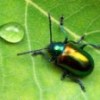
Arizona
New species discovery is not so simple as finding a critter in the woods and declaring âEureka!â A background knowledge of related species is essential for recognizing something novel. Trachymyrmex has been an especially challenging group of ants in this regard, as the published taxonomy of the group is limited and many of the species are confusingly similar. In the absence of a taxonomic synthesis, one is reduced to using isolated taxonomic papers written decades ago on individual species and going through endless drawers of museum specimens. Fortunately, Rabeling et al. do exactly that for the North American Trachymyrmex, and on top of it they throw in DNA sequence data from two loci sampled across multiple populations per species. Once the dust settled, they inferred the existence of nine species but had only eight valid, pre-existing names to apply to them. The extra species became the new T. pomonae.
Students of the biannual Ant Course in Arizona might recognize T. pomonae. It is not an uncommon ant around the Southwestern Research Station in Portal where the course is taught. If youâre an Arizona Ant Course alumnus, check your collection!


what do you mean "biannual"?
Ah. Perhaps I should have said "biennial." What I meant was, the Ant Course occurs in Arizona once every two years.
o.. I thought they decide to hold it twice a year. This would be great ;)